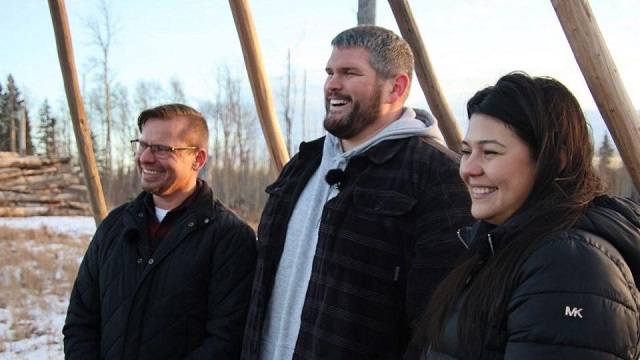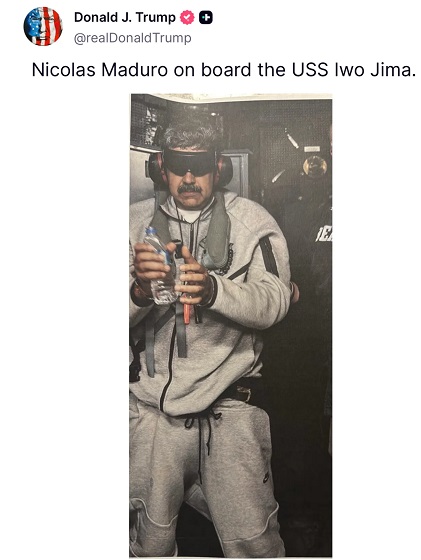Canadian Energy Centre
Why Canada’s proposed oil and gas emissions cap goes against UNDRIP and the rights of Indigenous people

Indigenous Resource Network executive director John Desjarlais (centre), with Justin Bourque, president of Âsokan Generational Developments, and Shelby Kennedy, community and Indigenous relations advisor with Enbridge. Photo courtesy Indigenous Resource Network
From the Canadian Energy Centre
Q&A with John Desjarlais, executive director of the Indigenous Resource Network
The Indigenous Resource Network (IRN) is pushing back on Canada’s proposed framework to cap emissions from the oil and gas sector.
IRN executive director John Desjarlais says the proposal directly contradicts Canada’s support for the United Nations Declaration on the Rights of Indigenous People (UNDRIP).
He says the plan would cap opportunity for Indigenous communities as more take on ownership positions in major energy projects from oil and gas pipelines to liquefied natural gas terminals and carbon capture and storage projects.
Here’s what Desjarlais told CEC.
CEC: From the perspective of Indigenous communities across Canada who are involved in natural resources development, what’s your take on the federal government’s proposed oil and gas emissions cap?
John Desjarlais: There’s a lot of confidence that it will curtail production as well, and obvious concern that it’s going to mean less opportunity.
We’ve heard from communities that are saying we’re involved already in emissions reduction. There are communities that just want to advance their opportunities in that space. And it’s at a time when there’s probably the greatest appetite for Indigenous involvement, not just in ownership, but advanced business development and procurement. [It could] mean less jobs, less procurement, less ownership opportunity, less investment.
There are concerns that these impacts are not being heavily understood, measured, contemplated or considered in terms of the policy development and implementation.
CEC: How does being involved in oil and gas development benefit Indigenous communities?
JD: There’s a suite of benefits that are coming from increased engagement, and it’s much deeper than just jobs.
Communities are now jumping into revenue generating assets where they’re creating immediate cash flow, which is allowing them to start to self-determine and invest back into their community either through economic development or through infrastructure programming.
The other side to it is just the capacity that comes from being involved as an owner. Indigenous business and community leaders are being exposed to the requirements and the acumen needed to successfully participate in the ownership of decision making. That’s accelerating the development of the acumen and capacity of different indigenous communities at greater rates
CEC: How many communities would you estimate are now participating at this level?
JD: There’s probably upwards directly of at least 100 different communities now. There are double-digit communities that are involved in at least four or five different deals that are directly involved in the ownership and the benefit side, and then there’s cascading involvement of all the surrounding communities through procurement opportunities and employment. It’s growing quite quickly.
CEC: Why do you say the proposed emissions cap contradicts the United Nations Declaration on the Rights of Indigenous People?
It’s a policy that’s created to achieve certain goals. Creating those types of targets without Indigenous oversight – not just input, [but] oversight and ownership – is problematic because it contradicts the UNDRIP action plan in terms of stepping out of the way of affording Indigenous peoples and communities the ability to self-determine; to invest where they want to invest, and to grow how they want to grow.
We hear a lot of community leaders say, ‘we know what’s best for our territories.’ To have policy that limits our ability to make the decisions we want to make in regard to environmental and economic sustainability is a challenge.
CEC: What would you like to see happen?
JD: It’s a little hard to roll back and involve communities in a total redesign, but at least if we saw an understanding that there’s certainly going to be an economic impact. If there’s a production cap aspect to it, there’s going to be an economic impact to those Indigenous communities that have established livelihoods and revenue streams.
There’s the sentiment that if the government truly is advancing this in the direction that they are, then would they consider omission of Indigenous activity so they can continue advancing their economic interests and growth?
Ideally, [there would be] a policy that’s created in line with UNDRIP that works for communities, industries and governments in their goals.
Alberta
The Canadian Energy Centre’s biggest stories of 2025

From the Canadian Energy Centre
Canada’s energy landscape changed significantly in 2025, with mounting U.S. economic pressures reinforcing the central role oil and gas can play in safeguarding the country’s independence.
Here are the Canadian Energy Centre’s top five most-viewed stories of the year.
5. Alberta’s massive oil and gas reserves keep growing – here’s why

The Northern Lights, aurora borealis, make an appearance over pumpjacks near Cremona, Alta., Thursday, Oct. 10, 2024. CP Images photo
Analysis commissioned this spring by the Alberta Energy Regulator increased the province’s natural gas reserves by more than 400 per cent, bumping Canada into the global top 10.
Even with record production, Alberta’s oil reserves – already fourth in the world – also increased by seven billion barrels.
According to McDaniel & Associates, which conducted the report, these reserves are likely to become increasingly important as global demand continues to rise and there is limited production growth from other sources, including the United States.
4. Canada’s pipeline builders ready to get to work
Canada could be on the cusp of a “golden age” for building major energy projects, said Kevin O’Donnell, executive director of the Mississauga, Ont.-based Pipe Line Contractors Association of Canada.
That eagerness is shared by the Edmonton-based Progressive Contractors Association of Canada (PCA), which launched a “Let’s Get Building” advocacy campaign urging all Canadian politicians to focus on getting major projects built.
“The sooner these nation-building projects get underway, the sooner Canadians reap the rewards through new trading partnerships, good jobs and a more stable economy,” said PCA chief executive Paul de Jong.
3. New Canadian oil and gas pipelines a $38 billion missed opportunity, says Montreal Economic Institute

Steel pipe in storage for the Trans Mountain Pipeline expansion in 2022. Photo courtesy Trans Mountain Corporation
In March, a report by the Montreal Economic Institute (MEI) underscored the economic opportunity of Canada building new pipeline export capacity.
MEI found that if the proposed Energy East and Gazoduq/GNL Quebec projects had been built, Canada would have been able to export $38 billion worth of oil and gas to non-U.S. destinations in 2024.
“We would be able to have more prosperity for Canada, more revenue for governments because they collect royalties that go to government programs,” said MEI senior policy analyst Gabriel Giguère.
“I believe everybody’s winning with these kinds of infrastructure projects.”
2. Keyera ‘Canadianizes’ natural gas liquids with $5.15 billion acquisition

Keyera Corp.’s natural gas liquids facilities in Fort Saskatchewan, Alta. Photo courtesy Keyera Corp.
In June, Keyera Corp. announced a $5.15 billion deal to acquire the majority of Plains American Pipelines LLP’s Canadian natural gas liquids (NGL) business, creating a cross-Canada NGL corridor that includes a storage hub in Sarnia, Ontario.
The acquisition will connect NGLs from the growing Montney and Duvernay plays in Alberta and B.C. to markets in central Canada and the eastern U.S. seaboard.
“Having a Canadian source for natural gas would be our preference,” said Sarnia mayor Mike Bradley.
“We see Keyera’s acquisition as strengthening our region as an energy hub.”
1. Explained: Why Canadian oil is so important to the United States

Enbridge’s Cheecham Terminal near Fort McMurray, Alberta is a key oil storage hub that moves light and heavy crude along the Enbridge network. Photo courtesy Enbridge
The United States has become the world’s largest oil producer, but its reliance on oil imports from Canada has never been higher.
Many refineries in the United States are specifically designed to process heavy oil, primarily in the U.S. Midwest and U.S. Gulf Coast.
According to the Alberta Petroleum Marketing Commission, the top five U.S. refineries running the most Alberta crude are:
- Marathon Petroleum, Robinson, Illinois (100% Alberta crude)
- Exxon Mobil, Joliet, Illinois (96% Alberta crude)
- CHS Inc., Laurel, Montana (95% Alberta crude)
- Phillips 66, Billings, Montana (92% Alberta crude)
- Citgo, Lemont, Illinois (78% Alberta crude)
Alberta
Alberta’s huge oil sands reserves dwarf U.S. shale

From the Canadian Energy Centre
By Will Gibson
Oil sands could maintain current production rates for more than 140 years
Investor interest in Canadian oil producers, primarily in the Alberta oil sands, has picked up, and not only because of expanded export capacity from the Trans Mountain pipeline.
Enverus Intelligence Research says the real draw — and a major factor behind oil sands equities outperforming U.S. peers by about 40 per cent since January 2024 — is the resource Trans Mountain helps unlock.
Alberta’s oil sands contain 167 billion barrels of reserves, nearly four times the volume in the United States.
Today’s oil sands operators hold more than twice the available high-quality resources compared to U.S. shale producers, Enverus reports.
“It’s a huge number — 167 billion barrels — when Alberta only produces about three million barrels a day right now,” said Mike Verney, executive vice-president at McDaniel & Associates, which earlier this year updated the province’s oil and gas reserves on behalf of the Alberta Energy Regulator.
Already fourth in the world, the assessment found Alberta’s oil reserves increased by seven billion barrels.
Verney said the rise in reserves despite record production is in part a result of improved processes and technology.
“Oil sands companies can produce for decades at the same economic threshold as they do today. That’s a great place to be,” said Michael Berger, a senior analyst with Enverus.
BMO Capital Markets estimates that Alberta’s oil sands reserves could maintain current production rates for more than 140 years.
The long-term picture looks different south of the border.
The U.S. Energy Information Administration projects that American production will peak before 2030 and enter a long period of decline.
Having a lasting stable source of supply is important as world oil demand is expected to remain strong for decades to come.
This is particularly true in Asia, the target market for oil exports off Canada’s West Coast.
The International Energy Agency (IEA) projects oil demand in the Asia-Pacific region will go from 35 million barrels per day in 2024 to 41 million barrels per day in 2050.
The growing appeal of Alberta oil in Asian markets shows up not only in expanded Trans Mountain shipments, but also in Canadian crude being “re-exported” from U.S. Gulf Coast terminals.
According to RBN Energy, Asian buyers – primarily in China – are now the main non-U.S. buyers from Trans Mountain, while India dominates purchases of re-exports from the U.S. Gulf Coast. .
BMO said the oil sands offers advantages both in steady supply and lower overall environmental impacts.
“Not only is the resulting stability ideally suited to backfill anticipated declines in world oil supply, but the long-term physical footprint may also be meaningfully lower given large-scale concentrated emissions, high water recycling rates and low well declines,” BMO analysts said.
-

 International1 day ago
International1 day ago“Captured and flown out”: Trump announces dramatic capture of Maduro
-

 International1 day ago
International1 day agoTrump Says U.S. Strike Captured Nicolás Maduro and Wife Cilia Flores; Bondi Says Couple Possessed Machine Guns
-

 Energy1 day ago
Energy1 day agoThe U.S. Just Removed a Dictator and Canada is Collateral Damage
-

 International1 day ago
International1 day agoUS Justice Department Accusing Maduro’s Inner Circle of a Narco-State Conspiracy
-

 Haultain Research1 day ago
Haultain Research1 day agoTrying to Defend Maduro’s Legitimacy
-

 Business1 day ago
Business1 day agoVacant Somali Daycares In Viral Videos Are Also Linked To $300 Million ‘Feeding Our Future’ Fraud
-

 Daily Caller15 hours ago
Daily Caller15 hours agoTrump Says US Going To Run Venezuela After Nabbing Maduro
-

 International1 day ago
International1 day agoU.S. Claims Western Hemispheric Domination, Denies Russia Security Interests On Its Own Border




